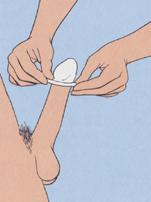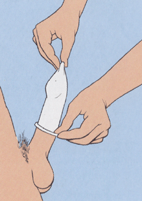|
Some tips for
purchasing and using
Condoms
-
Latex
condoms — when used consistently and correctly — are highly effective
barriers against pregnancy and STDs. Latex condoms are the
only condoms that prevent transmission of HIV.
-
The
newer plastic condoms have been proven in recent, limited laboratory
studies to be an effective barrier against HIV, but less is known
about their practical use except that they make a good alternative
for people who are allergic to latex. (There is some concern about
plastic condoms slipping off during use because of their rigidity;
they do not adhere to the body in the same manner latex condoms
do).
-
Animal
skin (lambskin) condoms do not offer an adequate barrier of protection
against STDs even though they do work as a contraceptive; viruses
and bacteria (not sperm) can pass through naturally occurring
"holes" in these condoms.
-
The
new female condom (basically a plastic condom in reverse that
is inserted into the vagina), like the male plastic condom, has
been shown to be an effective barrier against HIV in laboratory
studies. Although its practical use is still being studied, it
provides women a choice that offers protection against STDs.
-
Avoid
novelty condoms; warnings on the package usually indicate these
do not protect against STDs.
-
Vending
machine condoms are fine to use if they are made of latex, are
marked "for disease prevention," and have not been exposed to
direct sunlight in the machine.
-
Condoms
marketed as "stronger" or more "sensitive" do not offer more or
less protection; just be aware that thinner condoms may be more
prone to tearing.
-
When
it comes to condoms, size does matter; if a condom is too tight,
it's more likely to break. If it's too loose, it's more likely
to slip off.
-
Ribbed
condoms are as effective at protection as non-ribbed; it's a matter
of personal preference.
-
It
makes sense that a condom lubricated with a spermicide (a contraceptive
chemical) would offer slightly more protection against pregnancy
than one without.
-
Proper
lubrication may reduce the risk of the condom tearing.
-
If
the condom is not lubricated and lubrication is necessary, use
a water-based lubricant, such as K-Y jelly, on the outside of
the condom.
-
Do
not use petroleum or mineral-based lubricants, such as petroleum
jelly or baby oil, which can weaken latex condoms, causing them
to break.
-
Do
not use condoms that are brittle, gummy or discolored. Always
check the expiration date of a condom.
-
To
be fully protected, use a condom during any sexual activity,
whether vaginal, oral or anal.
-
Tear
open the package carefully.
-
Gently
press out air at the tip of the condom before putting it on. An
air bubble may cause the condom to tear or come off.
-
Place
the tip of the rolled-up condom over the firm penis. (The rolled
rim should be on the outside).
-
Make
sure that as you unroll the condom down over the entire penis,
you leave ample room — a half-inch space — at the tip for
semen to collect unless the condom comes designed with a "reservoir"
tip.
-
Smooth
out any air bubbles to ensure the condom fits securely.
-
If
you are uncircumcised, make sure the foreskin is pulled back
before you put on the condom.
-
After
intercourse of any kind, remember to hold on tight to the condom
at the rim and pull out slowly while the penis is still hard,
to prevent spillage.
-
Never
reuse any condom; if you put a condom on backwards and it
does not unroll easily, don't flip it over since there may be
semen in it. Use another.
-
Store
condoms in a cool, dry place because extreme temperatures can
damage them. Body
heat will cause latex to deteriorate, so it's not a good idea
to keep condoms in a wallet.
-
When
used consistently and correctly, condoms offer reliable protection
-
Most
condoms fail because of user error. Remember
the three C's when it comes to condoms: use them carefully,
correctly and consistently.
-
Remember,
too, that condoms cannot protect you from every STD, such
as genital warts or herpes in cases where an open sore or wart
at the base of the penis cannot be adequately covered by a condom
and skin-to-skin contact between partners occurs.
Source:
Courtesy of Mayo Clinic.
|


Click here
to view how to wear a condom
(video clip
253 k)
|
|

